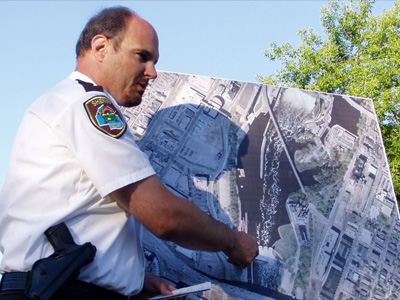
One of the great joys of the journalism business is when a small story (in the big scheme of things) grows legs and then scampers all over the news business. The Star Tribune story of Hennepin County Sheriff Rich Stanek’s promotional video of his the county’s response to the I-35W bridge collapse is a perfect example.
The original story detailed a heavy-on-Stanek “training” video that was shown to the men’s group at the Mt. Olivet Lutheran Church in Minneapolis, and led to the question of whether Stanek was preparing another run for public office.
KARE picked up the story, and quoted Stanek as having no comment because he hadn’t read the Star Tribune story. (You have to read the newspaper story to answer the question about the purpose of a DVD your staff produced?)
By Monday, Stanek was able to answer the question of the propriety of spending $30,000 for the video (which can be viewed here)
“You know, I disagree,” Stanek said Monday, in response to the concerns. “I’ve spoken to the commissioners that commented over the weekend in the local paper. They did not have the benefit of seeing the presentation that goes with the video. They saw snippets of it.”
Brian Lambert, the media critic and blogger, intercepted a copy of an e-mail that showed how Stanek’s video was playing with some of the other people who responded to the I-35W bridge collapse.
“His theft of the credit is not going to sit well with my staff and our hard working partners,” Minneapolis police chief Tim Dolan said in the e-mail.
KMSP picked it up from there on Tuesday, reinforcing the notion that this is a not-so-thinly-veiled campaign video, by finding that the St. Cloud company that produced the video, is the same company that handled advertising and marketing for Stanek’s campaign in 2006. KMSP’s report suggested Stanek’s splitting the $30,000 contract in two, was designed to avoid the rule that requires contracts higher than $15,000 to be put out to public bid.
In fairness to Stanek, he wasn’t exactly keeping the involvement of the company a secret, since on his Web site it says…
As part of the historical documentation of the Hennepin County Sheriff’s Office work at the I-35W Bridge Collapse, we put together an informational and training video with the assistance of Johnson Group and Quarterton Productions. It has been an incredible asset as I travel the country to speak at various public and law enforcement events, helping to really tell the story of how preparedness, focus and the extraordinary efforts made by an excellent team created the conditions for us to complete our mission of rescue and recovery at this disaster site.
And the intro to the video itself makes clear Stanek’s department wasn’t the only agency involved in the recovery from the catastrophe. Plus there’s this: Stanek — and all the responders — did a great job. Regardless of who gets credit for it, a discussion about the lessons learned (and it’s important to note the video is part of a presentation, not the whole thing), is likely to lead to someone’s life being saved. That’s a good thing. Besides, anyone who’s ever been at a seminar knows that the real training starts with the Q&A after the big flashy presentations end.
Lambert was back on the story again today, exploring the angle of the role of WCCO anchor Don Shelby, who narrates the video.
“What I was told was that this was going to be a training video to be shown at a national conference in D.C., and that I’d just be doing the ins and outs. They never said how often this would be shown. But my clear understanding was that it was just for this one national conference and then training for first responders. I was never told it would run publicly here in Minnesota much less at a Mount Olivet men’s group.”
So many angles in such a short period of time. And yet, the original question persists. Is Rich Stanek running for something?
This video, by the way, wasn’t the dawn of “training” multimedia produced in the wake of the bridge accident. Firehouse.com produced “Leader’s Toolbox: Lessons learned from the Minneapolis bridge collapse” with Minneapolis fire chief Jim Clack.
Clack was also on a panel in Oklahoma last month, “Minneapolis Bridge Collapse: Lessons Learned.” so was Deputy Police Chief Rob Allen, and John Hick, medical director of Hennepin County Medical Center.
Ironically, perhaps, the least visible member of the response team is also the one many have hailed as a hero, mostly for putting work into an emergency plan ahead of time. Rocco Forte, who heads the Minneapolis emergency response team, reportedly had a bridge disaster group in place within 8 minutes of the bridge collapse.
